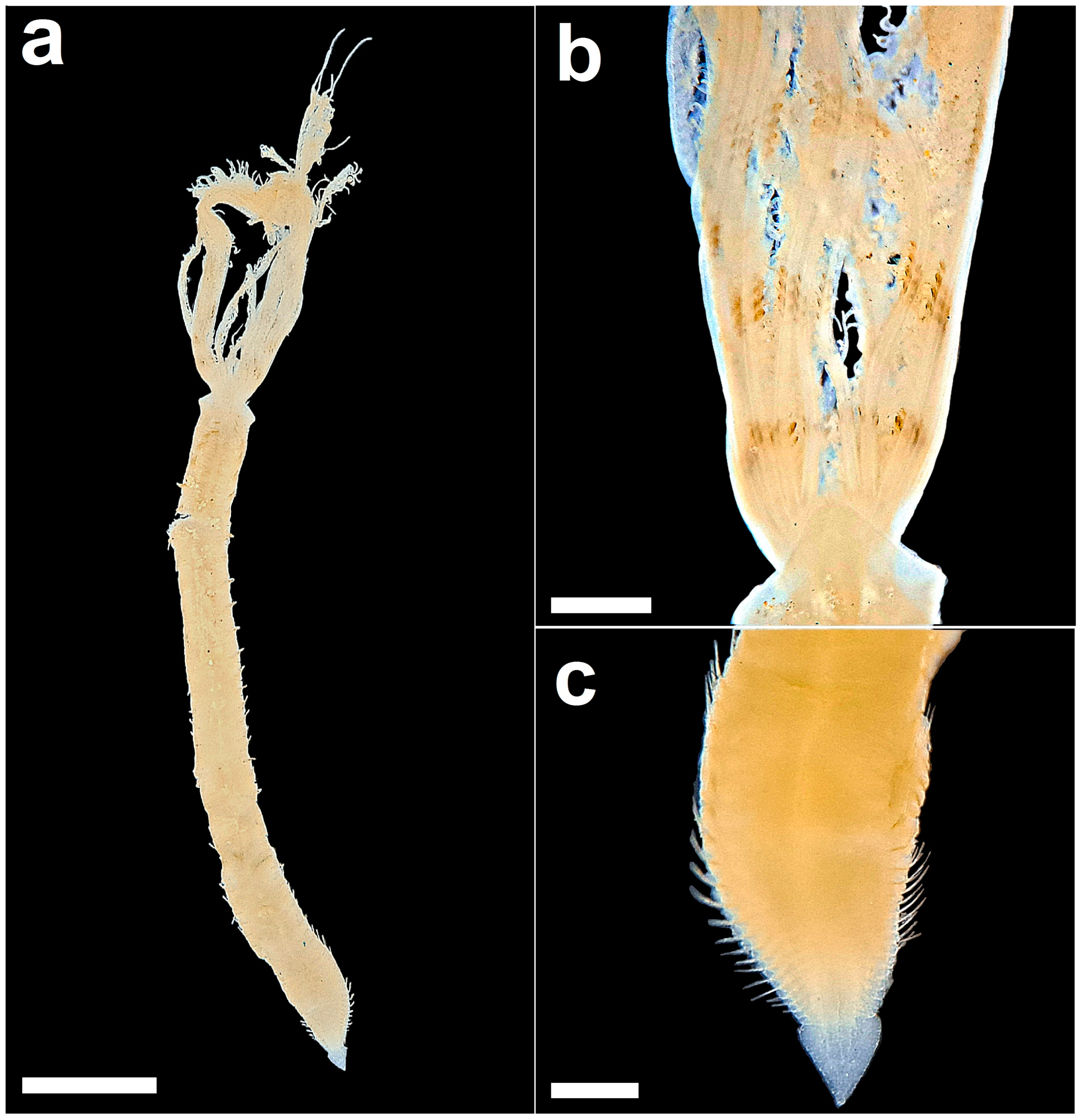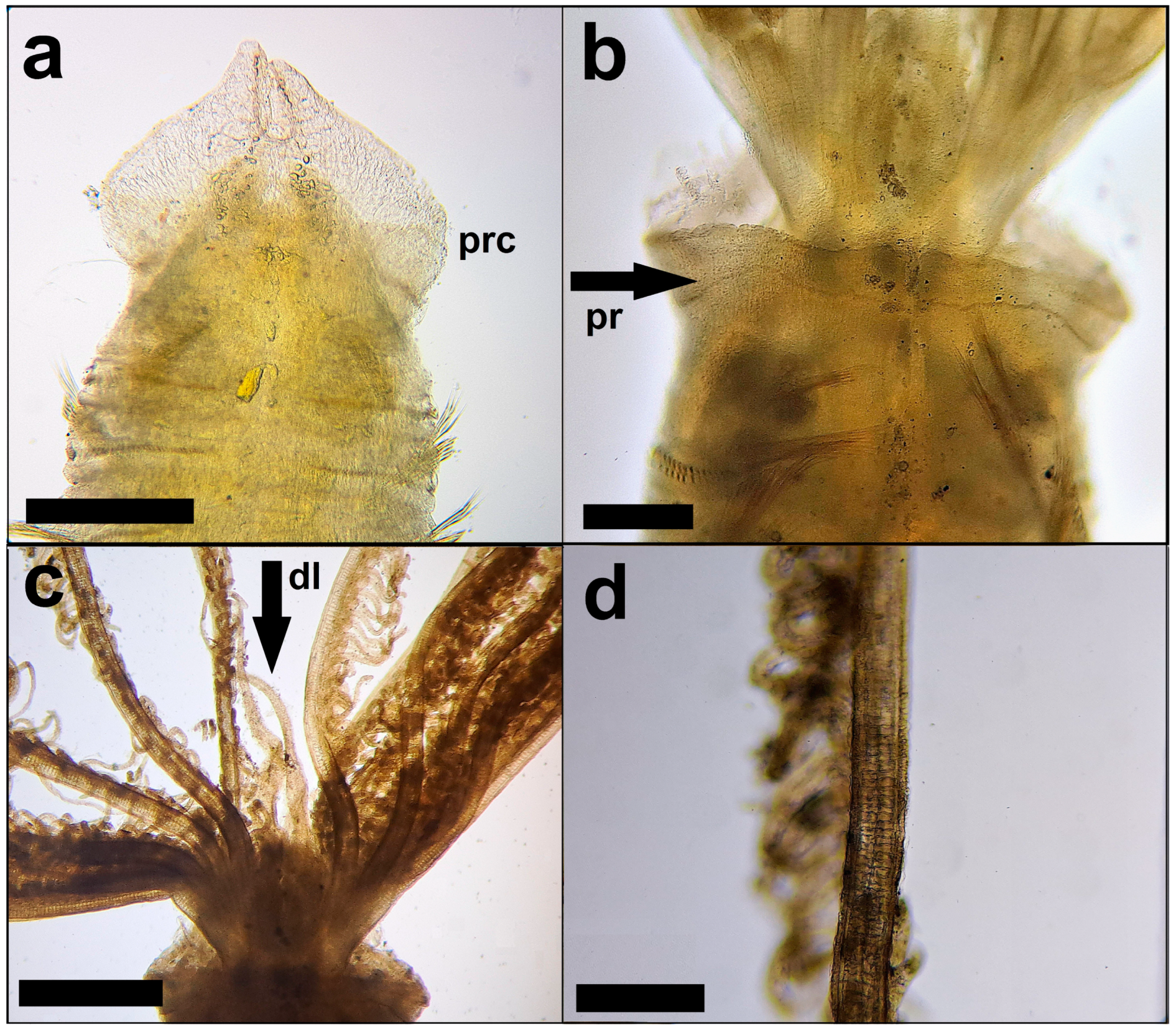First Record of the Alien and Invasive Polychaete Laonome triangularis Hutchings & Murray, 1984 (Annelida, Sabellidae) in Italian Waters
Abstract
:Author Contributions
Funding
Institutional Review Board Statement
Informed Consent Statement
Data Availability Statement
Conflicts of Interest
References
- Çinar, M.E. Alien polychaete species (Annelida: Polychaeta) on the southern coast of Turkey (Levantine Sea, eastern Mediterranean), with 13 new records for the Mediterranean Sea. J. Nat. Hist. 2009, 43, 2283–2328. [Google Scholar] [CrossRef]
- Zenetos, A.; Gofas, S.; Verlaque, M.; Cinar, M.; Garcia Raso, J.; Bianchi, C.; Morri, C.; Azzurro, E.; Bilecenoglu, M.; Froglia, C.; et al. Alien species in the Mediterranean Sea by 2010. A contribution to the application of European Union’s Marine Strategy Framework Directive (MSFD). Part I. Spatial distribution. Mediterr. Mar. Sci. 2010, 11, 381–493. [Google Scholar] [CrossRef] [Green Version]
- Seebens, H.; Blackburn, T.M.; Dyer, E.E.; Genovesi, P.; Hulme, P.E.; Jeschke, J.M.; Essl, F. No saturation in the accumulation of alien species worldwide. Nat. Commun. 2017, 8, 14435. [Google Scholar] [CrossRef] [PubMed]
- Ragkousis, M.; Zenetos, A.; Ben Souissi, J.; Tsiamis, K.; Ferrario, J.; Marchini, A.; Edelist, D.; Crocetta, F.; Bariche, M.; Deidun, A.; et al. Unpublished Mediterranean and Black Sea records of marine alien, cryptogenic, and neonative species. BioInvasions Rec. 2023, 12, 339–369. [Google Scholar] [CrossRef]
- Capa, M. Taxonomic revision and phylogenetic relationships of apomorphic sabellids (Polychaeta) from Australia. Invertebr. Syst. 2007, 21, 537–567. [Google Scholar] [CrossRef]
- Hutchings, P.A.; Murray, A. Taxonomy of polychaetes from the Hawkesbury River and the southern estuaries of New South Wales, Australia. Rec. Aust. Mus. 1984, 3, 1–118. [Google Scholar] [CrossRef] [Green Version]
- Bonifazi, A.; Mancini, E.; Ventura, D. First record of the invasive and cryptogenic species Jassa slatteryi (Crustacea: Amphipoda) in Italian coastal waters. J. Sea Res. 2017, 136, 37–41. [Google Scholar] [CrossRef]
- Tempesti, J.; Mangano, M.C.; Langeneck, J.; Lardicci, C.; Maltagliati, F.; Castelli, A. Non-indigenous species in Mediterranean ports: A knowledge baseline. Mar. Environ. Res. 2020, 161, 105056. [Google Scholar] [CrossRef] [PubMed]
- Tempesti, J.; Langeneck, J.; Maltagliati, F.; Castelli, A. Macrobenthic fouling assemblages and NIS success in a Mediterranean port: The role of use destination. Mar. Pollut. Bull. 2020, 150, 110768. [Google Scholar] [CrossRef] [PubMed]



Disclaimer/Publisher’s Note: The statements, opinions and data contained in all publications are solely those of the individual author(s) and contributor(s) and not of MDPI and/or the editor(s). MDPI and/or the editor(s) disclaim responsibility for any injury to people or property resulting from any ideas, methods, instructions or products referred to in the content. |
© 2023 by the authors. Licensee MDPI, Basel, Switzerland. This article is an open access article distributed under the terms and conditions of the Creative Commons Attribution (CC BY) license (https://creativecommons.org/licenses/by/4.0/).
Share and Cite
Bonifazi, A.; Lombardo, M.F.; De Bonis, S.; Caprioli, R.; Fustolo, M.; Morgana, S.; Pierdomenico, M.; Mancini, E. First Record of the Alien and Invasive Polychaete Laonome triangularis Hutchings & Murray, 1984 (Annelida, Sabellidae) in Italian Waters. Diversity 2023, 15, 771. https://doi.org/10.3390/d15060771
Bonifazi A, Lombardo MF, De Bonis S, Caprioli R, Fustolo M, Morgana S, Pierdomenico M, Mancini E. First Record of the Alien and Invasive Polychaete Laonome triangularis Hutchings & Murray, 1984 (Annelida, Sabellidae) in Italian Waters. Diversity. 2023; 15(6):771. https://doi.org/10.3390/d15060771
Chicago/Turabian StyleBonifazi, Andrea, Marco Felice Lombardo, Salvatore De Bonis, Riccardo Caprioli, Martina Fustolo, Silvia Morgana, Martina Pierdomenico, and Emanuele Mancini. 2023. "First Record of the Alien and Invasive Polychaete Laonome triangularis Hutchings & Murray, 1984 (Annelida, Sabellidae) in Italian Waters" Diversity 15, no. 6: 771. https://doi.org/10.3390/d15060771
APA StyleBonifazi, A., Lombardo, M. F., De Bonis, S., Caprioli, R., Fustolo, M., Morgana, S., Pierdomenico, M., & Mancini, E. (2023). First Record of the Alien and Invasive Polychaete Laonome triangularis Hutchings & Murray, 1984 (Annelida, Sabellidae) in Italian Waters. Diversity, 15(6), 771. https://doi.org/10.3390/d15060771






